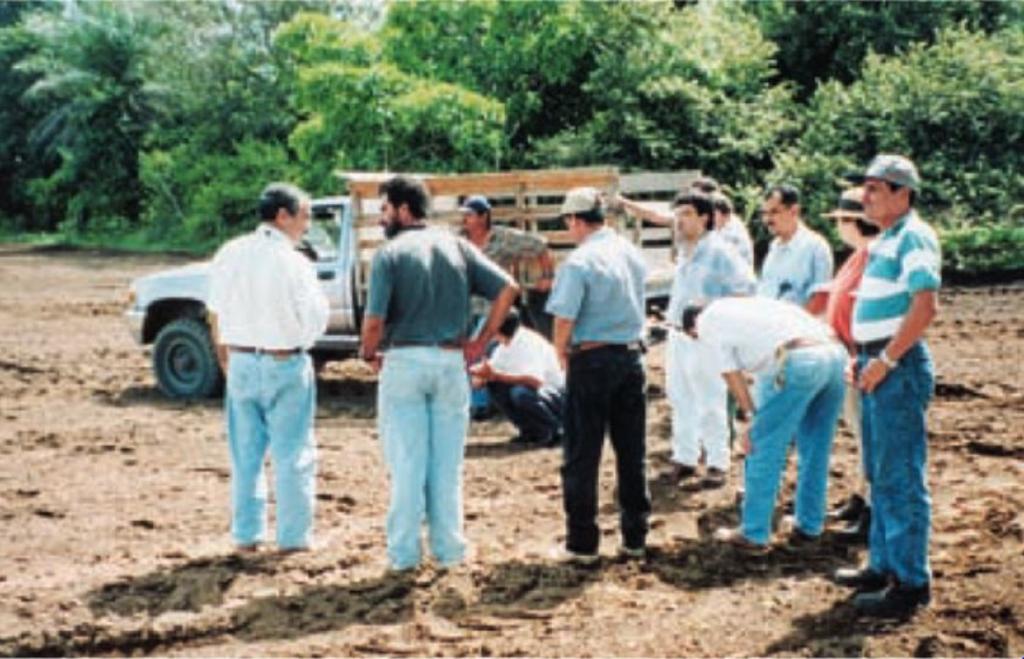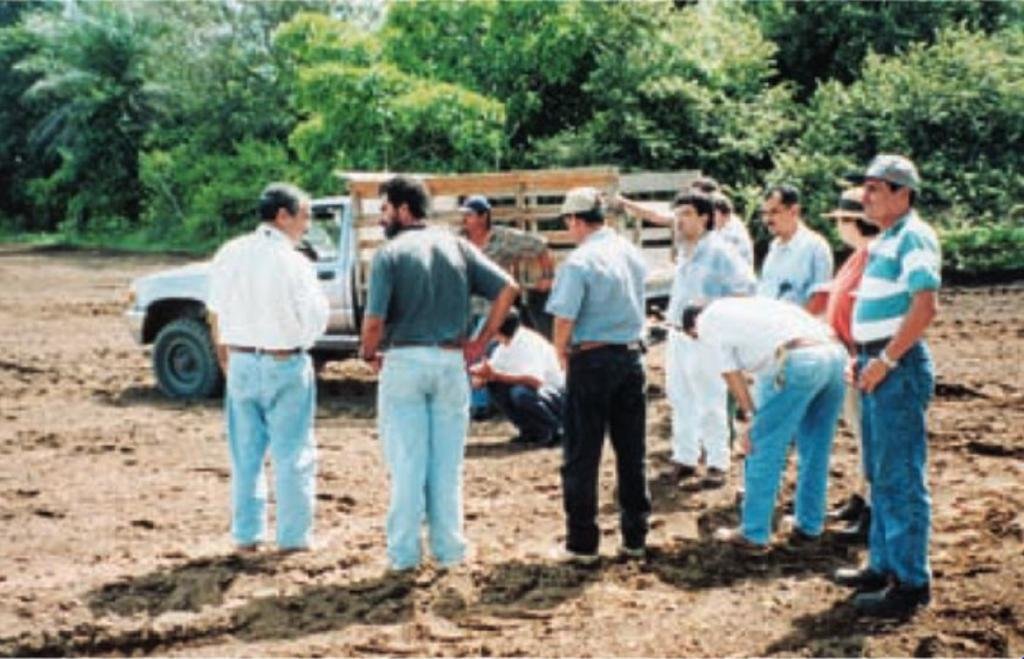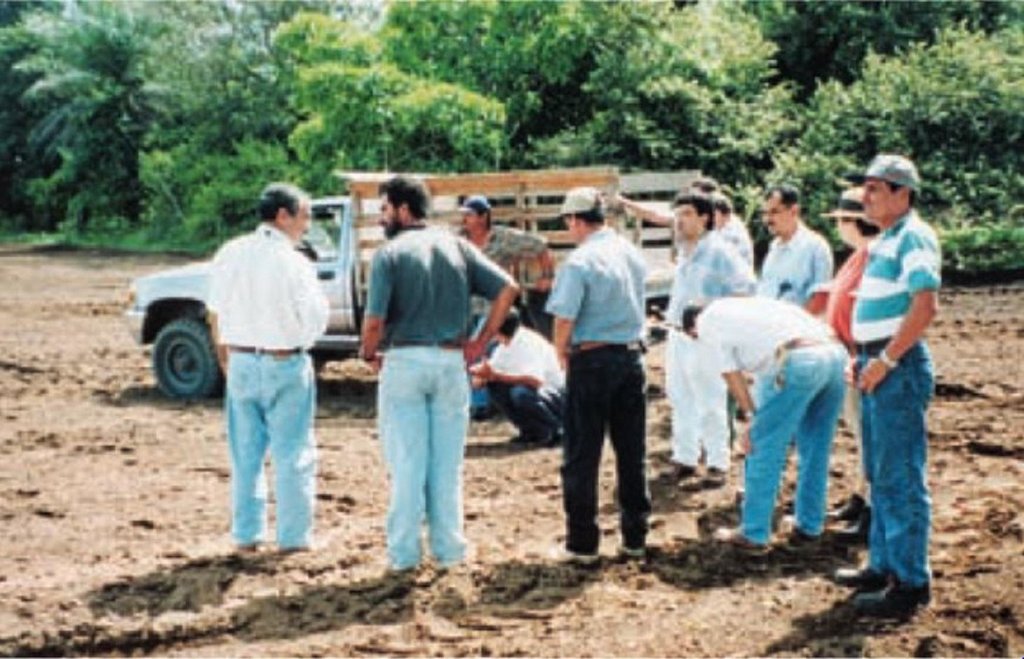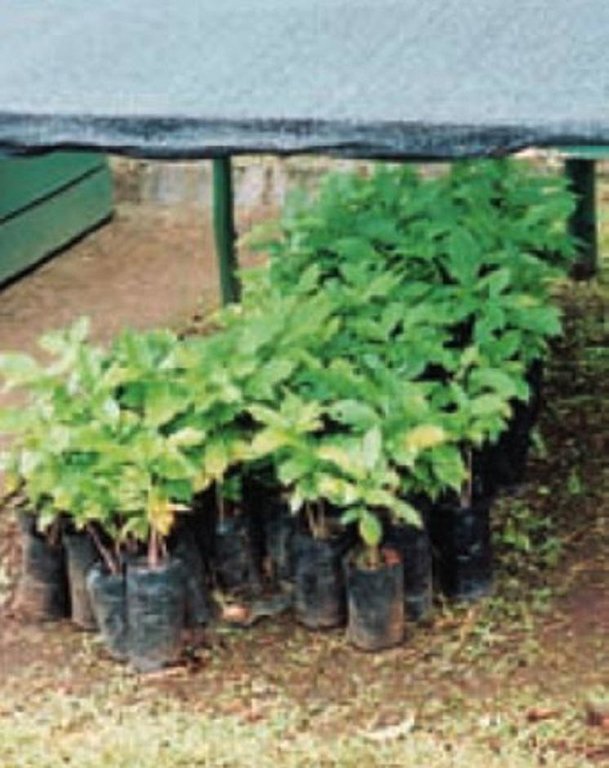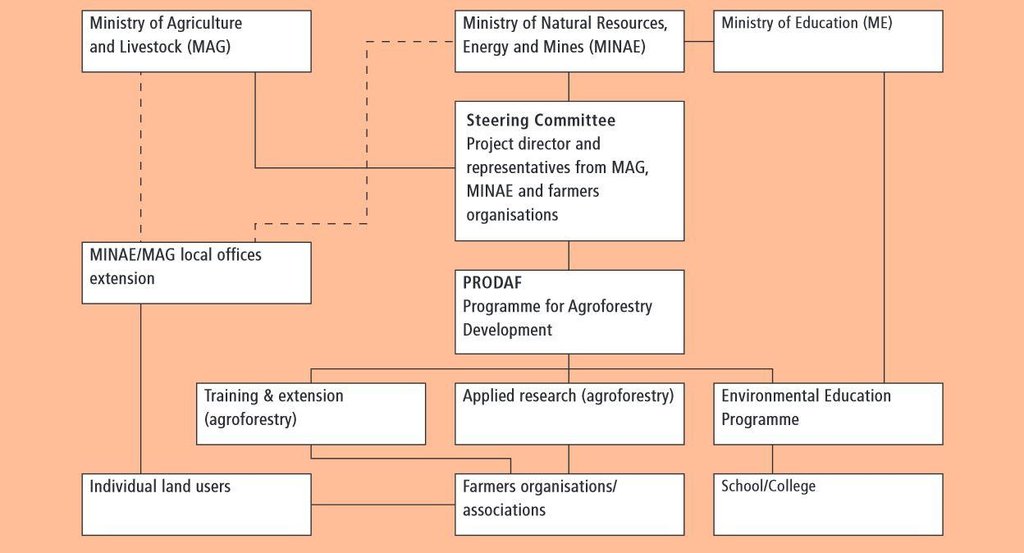Agroforestry extension [كوستاريكا]
- تاريخ الإنشاء:
- تحديث:
- جامع المعلومات: Olman Quiros Madrigal
- المحرر: –
- المراجعون: David Streiff, Deborah Niggli
approaches_2391 - كوستاريكا
عرض الأقسام
توسيع الكل طي الكل1. معلومات عامة
1.2 تفاصيل الاتصال بالأشخاص الرئيسيين لمصدر المعلومات والمؤسسات المعنية بتقييم وتوثيق النهج
اسم المشروع الذي سهّل توثيق/تقييم النهج (إذا كان ذلك على صلة)
Book project: where the land is greener - Case Studies and Analysis of Soil and Water Conservation Initiatives Worldwide (where the land is greener)1.3 الشروط المتعلقة باستخدام البيانات الموثقة من خلال WOCAT
يوافق جامع المعلومات والشخص (لاشخاص) الرئيسي لمصدر المعلومات على الشروط المتعلقة باستخدام البيانات الموثقة من خلال WOCAT:
نعم
1.4 المراجع الخاصة باستبيان(استبيانات) تقنيات الإدارة المستدامة للأراضي
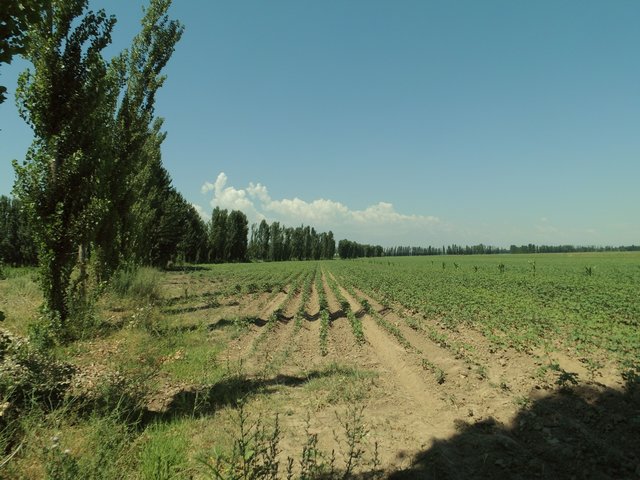
Tree windbreaks within irrigated agriculture in Central Asia [قرغيزستان]
Windbreaks of poplar trees (Populus nigra pyramidalis) are a major agroforestry system in irrigated agriculture across Central Asia. Such windbreaks reduce the overall water consumption of irrigated agriculture by 10-20% and increase farm income by 10-15%.
- جامع المعلومات: Niels Thevs
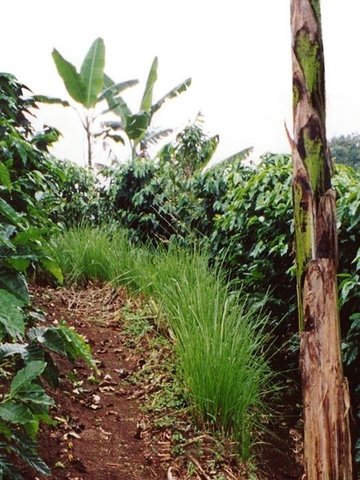
Shade-grown coffee [كوستاريكا]
An agroforestry system which combines coffee with shade trees - including fruit, timber and leguminous species - in a systematic fashion.
- جامع المعلومات: Olman Quiros Madrigal
2. وصف نهج الإدارة المستدامة للأراضي
2.1 وصف موجز للنهج
Participatory extension of agroforestry systems, especially of shadegrown coffee, to promote sustainable and productive use of natural resources among small and medium scale farmers.
2.2 وصف تفصيلي للنهج
وصف تفصيلي للنهج:
Aims / objectives: The Programme for Agroforestry Development (PRODAF) pioneered a new type of agroforestry extension in Costa Rica between 1987 and 1994. PRODAF was positioned under two national ministries (the Ministry of Agriculture and Livestock - MAG and the Ministry of Natural Resources, Energy and Mines - MINAE) and was supported by GTZ (German Technical Cooperation). Agroforestry extension underpinned the following sectors: environmental education, promotion of training and technical assistance in agriculture and forestry, development of programmes for afforestation and agroforestry systems, and promotion/support of farmers' organisations. The approach was based on land users' participation at all stages. The main purpose of the agroforestry extension approach was the development and promotion of sustainable production systems, which were adapted to the local biophysical and socio-economic conditions. This was to enable environmentally friendly production on steep slopes, while at the same time generating sufficient income for small and medium scale farmers in marginal areas of the Acosta-Puriscal region. In this case study, shade-grown coffee was identified to be a system that fulfilled these conditions. Another important objective was the involvement of all family members - including the younger generation.
Role of stakeholders: In the first years PRODAF operated with a top-down development approach implementing technologies, designed by specialists, without consultation of land users. Local needs and experiences were not considered: as a result both adoption of shade-grown coffee was low, and maintenance was poor, despite initial incentives. The change to a participatory, bottom-up approach, with land users being represented in the steering committee (which during this period was absolutely innovative) increased acceptance among the majority of farmers towards shade-grown coffee. Participation of land users during planning and implementation was rewarded with provision of tools, seeds, fertilizer and biocides (fully financed or subsidised). The technology was evaluated on the test plots within existing coffee plantations together with the land users. PRODAF's legacy has been an institutional change in Government policy towards extension.
2.3 صور عن النهج
2.5 البلد/المنطقة/المواقع التي تم تطبيق النهج فيها
البلد:
كوستاريكا
المنطقة/الولاية/المحافظة:
San José/Río Parrita
Map
×2.6 تواريخ بدء وإنهاء تنفيذ النهج
أشر إلى سنة البدء:
1987
سنة الإنهاء (إذا لم يعد النهج مطبقًا):
1994
2.7 نوع النهج
- قائم على مشروع/برنامج
2.8 الغايات/الأهداف الرئيسية للنهج
Promotion of appropriate management of natural resources and adoption of the shade-grown coffee agroforestry system - café arbolado - among small and medium scale farmers.
The SLM Approach addressed the following problems: - various different approaches of forest and agricultural technicians regarding choice and implementation of the technology, - which needed harmonising, - lack of incentives for farmers to adopt technology, - lack of participatory technology development
2.9 الظروف التي تمكن أو تعيق تنفيذ التقنية/التقنيات المطبقة بموجب النهج
توفر/الوصول إلى الموارد والخدمات المالية
- معيق
Lack of credit for SWC implementation.
Treatment through the SLM Approach: Credit has been made available through the 'productive re-conversion programme' and other credit systems for organic/conservation production, eg Fideicomiso (see under credit).
الإطار المؤسساتي
- معيق
Lack of collaboration and coordination between different institutions.
Treatment through the SLM Approach: Innovative incorporation of land users in decision making, which in the meantime has become a common approach.
الإطار القانوني (حيازة الأراضي، وحقوق استخدام الأراضي والمياه)
- تمكين/تمكيني
The existing land ownership, land use rights / water rights moderately helped the approach implementation: Land fragmentation leads to very small areas per household. This hinders implementation of SWC activities. Land users do not have the resources to invest in initial inputs and activities.
- معيق
Subdivision of land hinders adoption of SWC measures.
Treatment through the SLM Approach: Not directly treated by the approach. Diverse incentive mechanisms have to be identified to promote SWC activities on small areas.
المعرفة حول الإدارة المستدامة للأراضي، والوصول إلى الدعم الفني
- معيق
Lack of technical knowledge, lack of research activities/trials with SWC technologies.
Treatment through the SLM Approach: Promotion of alternative production systems and SWC measures had great impact. Technology was tested on-farm. PRODAF did not focus on research activities.
3. المشاركة وأدوار الأطراف المعنية
3.1 أصحاب المصلحة المعنيون بالنهج وأدوارهم
- مستخدمو الأراضي المحليون/المجتمعات المحلية
Mainly men participated: women are not usually expected to carry out field activities for cultural reasons. The coffee harvest is the only activity where men and women work together in the field.
- متخصصون في الإدارة المستدامة للأراضي / مستشارون زراعيون
- الحكومة الوطنية (المخططون، صانعو القرار)
3.2 انخراط مستخدمي الأراضي المحليين/المجتمعات المحلية في المراحل المختلفة للنهج
| انخراط مستخدمي الأراضي المحليين/المجتمعات المحلية | حدد من شارك وصف الأنشطة | |
|---|---|---|
| المبادرة/التحفيز | تفاعلي | rapid/participatory rural appraisal; good participation basically through participative rural appraisal |
| التخطيط | تفاعلي | workshops/seminars; incentives are provided for participating land users |
| التنفيذ | تفاعلي | responsibility for major steps; incentives are provided for participating land users |
| الرصد/التقييم | تفاعلي | workshop/seminars, interviews/questionnaires; |
| Research | تفاعلي | on-farm |
3.3 مخطط التدفق (إذا كان متاحًا)
3.4 اتخاذ القرار بشأن اختيار تقنية/تقنيات الإدارة المستدامة للأراضي
حدد من الذي قرر اختيار التقنية/التقنيات التي سيتم تنفيذها:
- متخصصون في الإدارة المستدامة للأراضي بشكل أساسي، بعد التشاور مع مستخدمي الأراضي
اشرح:
Decisions on the method of implementing the SLM Technology were made by mainly by SLM specialists with consultation of land users
4. الدعم الفني وبناء القدرات وإدارة المعرفة
4.1 بناء القدرات/التدريب
هل تم تقديم التدريب لمستخدمي الأراضي / الأطراف المعنيين الآخرين؟:
نعم
شكل التدريب:
- من مزارع إلى مزارع
- مناطق العرض
- اجتماعات عامة
شكل التدريب:
- trips to projects in, field days, workshops
المواضيع المغطاة:
The following subjects were treated: coffee agroforestry system, fruit trees and soil conservation, silvo-pastoralism, soil conservation in general. Beside knowledge transfer, awareness raising and motivation were important aims of training.
4.2 خدمة استشارية
هل يملك مستخدمو الأراضي وصولا إلى خدمة استشارية؟:
نعم
حدد ما إذا كانت الخدمة الاستشارية متوفرة:
- في حقول مستخدمي الأراضي
وصف/تعليقات:
Name of method used for advisory service: Extension carried out through extension workers was the key element of the overall approach; Key elements: the adequacy of extension for continuation was very good, Different methods were used: on-farm technical assistance; farmer-tofarmer knowledge exchange; demonstration areas and workshops.
4.3 تعزيز المؤسسات (التطوير التنظيمي)
هل تم إنشاء أو تعزيز مؤسسات من خلال هذا النهج؟:
- نعم، قليلا
حدد نوع الدعم:
- مالي
- بناء القدرات/التدريب
- معدات
4.4 الرصد والتقييم
هل يشكل الرصد والتقييم جزءا من النهج؟:
نعم
التعليقات:
Bio-physical aspects were ad hoc monitored by 0 through measurements; indicators: yields
Socio-cultural aspects were regular monitored by 0 through observations; indicators: family size
Economic / production aspects were regular monitored by 0 through measurements; indicators: yields and production market
No. of land users involved aspects were regular monitored by 0 through measurements; indicators: land users involved in organisation
There were many changes in the Approach as a result of monitoring and evaluation: The approach changed completely after evaluation of the first phase, from an initial top down methodology with low technology adoption by land users, to a more participative approach heeding land users' opinions and needs, and improving communication between technicians and land users. This was helped by the development of educational materials.
4.5 البحوث
هل كانت البحوث جزءًا من النهج؟:
نعم
حدد المواضيع:
- علم الايكولوجيا
- تكنولوجيا
أعط تفاصيل إضافية وأشر إلى من قام بالبحوث:
Results were rather meagre, and the effect on the approach was thus moderate. Previous to PRODAF there was a research project conducted by CATIE (Tropical Agricultural Research and Higher Education Centre) in the approach area, but results were not broadly disseminated.
Research was carried out on-farm
5. التمويل والدعم المادي الخارجي
5.1 الميزانية السنوية لمكون الإدارة المستدامة للأراضي في النهج المذكور
التعليقات (على سبيل المثال المصادر الرئيسية للتمويل/الجهات المانحة الرئيسية):
Approach costs were met by the following donors: government (national - MAG, MINAE): 50.0%; international non-government (GTZ): 50.0%
5.2 الدعم المالي/المادي المقدم لمستخدمي الأراضي
هل حصل مستخدمو الأراضي على دعم مالي/ مادي لتنفيذ التقنية/ التقنيات؟:
نعم
5.3 إعانات لمدخلات محددة (بما في ذلك العمالة)
- معدات
| حدد المدخلات التي تم دعمها | إلى أي مدى | حدد الإعانات |
|---|---|---|
| أدوات | ممول جزئيا | hand tools |
- زراعة
| حدد المدخلات التي تم دعمها | إلى أي مدى | حدد الإعانات |
|---|---|---|
| أسمدة | ممول جزئيا | |
| seedlings | ممول بالكامل | |
إذا كان العمل من قبل مستخدمي الأراضي مدخلاً جوهريًا، فهل كان:
- تطوعي
5.4 الائتمان
هل تم توفير ائتمان في إطار نهج أنشطة الإدارة المستدامة للأراضي؟:
نعم
حدد الشروط (معدل الفائدة، فترة السداد، الخ.):
Repayment conditions: Credit was provided through ‘productive re-conversion programme’ to support small-scale organic production and soil conservation. After PRODAF a larger (national) credit programme to promote agroforestry systems was launched, under MAG and National Production Council. Fideicomiso is another national financing programme based on a contract between a bank and development institutions. .
Interest was lower than market rate.
6. تحليل الأثر والتصريحات الختامية
6.1 آثار النهج
هل ساعد النهج مستخدمي الأراضي على تنفيذ وصيانة تقنيات الإدارة المستدامة للأراضي؟:
- لا
- نعم، قليلا
- نعم، باعتدال
- نعم، إلى حد كبير
There was substantial improvement of soil and water management through application of the agroforestry systems.
Did other land users / projects adopt the Approach?
- لا
- نعم، قليلا
- نعم، باعتدال
- نعم، إلى حد كبير
Some projects in the region as well as in other parts of the country adopted the approach. Various SWC extension programmes have adopted the extension methods promoted by PRODAF, based on the principles of land users participation. In the Ministry of Agriculture and Livestock it has been taken as a basic principle in the National Programme of Agricultural Extension.
6.3 استدامة أنشطة النهج
هل يمكن لمستخدمي الأراضي المحافظة على استدامة ما تم تنفيذه من خلال النهج (بدون دعم خارجي)؟:
- غير مؤكد
إذا كان الجواب لا أو غير متأكد، حدد ذلك وعلق عليه:
While the approach has been institutionalised and a national credit programme set up promoting shade-grown coffee and silvo-pastoral systems, continuation of field production activities is uncertain. Farmers’ motivation to apply technologies was raised with the Environmental Education Programme, but if market prices for coffee decrease /show variability, farmers lose the motivation to maintain i
6.4 نقاط قوة/مزايا النهج
| نقاط القوة/ المزايا/ الفرص من وجهة نظر جامع المعلومات أو غيره من الاشخاص الرئيسيين لمصدر المعلومات |
|---|
| Institutionalisation of the basic participatory extension approach within the Ministry of Agriculture and Livestock. |
| Initial top-down approach replaced by participation with land users (How to sustain/ enhance this strength: Continue to spread information about the effectiveness of this change in attitude, and the need for responsiveness in projects and programmes.) |
| Training of land users (knowledge of soil degradation processes and soil and water conservation) (How to sustain/ enhance this strength: Collaboration with farmers organisations, NGOs and agricultural extension services. Better dissemination of research results.) |
| Environmental education in schools (How to sustain/ enhance this strength: Continue support through the Ministry of Education.) |
6.5 نقاط الضعف/ العيوب في المنهج وطرق التغلب عليها
| نقاط الضعف/ المساوىء/ المخاطر من وجهة نظر جامع المعلومات أو غيره من الاشخاص الرئيسيين لمصدر المعلومات | كيف يمكن التغلب عليها؟ |
|---|---|
| No economic security guaranteed in the long term because of price fluctuations | Provide a system of incentives, eg lower taxes for those who apply SWC technologies. |
7. المراجع والروابط
7.1 طرق جمع/مصادر المعلومات
- زيارات ميدانية، مسوحات ميدانية
- مقابلات مع مستخدمي الأراضي
7.2 المراجع للمنشورات المتاحة
العنوان، المؤلف، السنة، النظام القياسي الدولي لترقيم الكتب ISBN:
PRODAF (1992) Informe de evaluación de las parcelas agroforestales establecidas por PRODAF, Periodo 88-91, Puriscal,Quiros O (2000) Nachhaltigkeit von landwirtschaftlichen Produktionsverfahren in bäuerlichen Familienbetrieben in Costa Rica.
متاح من أين؟كم التكلفة؟:
Vauk-Kiel KG: series of: Sozialökonimische Schriften zur Ruralen Entwicklung, Vol. 20
الروابط والوحدات المواضيعية
توسيع الكل طي الكلالروابط

Tree windbreaks within irrigated agriculture in Central Asia [قرغيزستان]
Windbreaks of poplar trees (Populus nigra pyramidalis) are a major agroforestry system in irrigated agriculture across Central Asia. Such windbreaks reduce the overall water consumption of irrigated agriculture by 10-20% and increase farm income by 10-15%.
- جامع المعلومات: Niels Thevs

Shade-grown coffee [كوستاريكا]
An agroforestry system which combines coffee with shade trees - including fruit, timber and leguminous species - in a systematic fashion.
- جامع المعلومات: Olman Quiros Madrigal
الوحدات المواضيعية
لا يوجد وحدات مواضيعية


